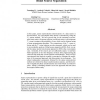Free Online Productivity Tools
i2Speak
i2Symbol
i2OCR
iTex2Img
iWeb2Print
iWeb2Shot
i2Type
iPdf2Split
iPdf2Merge
i2Bopomofo
i2Arabic
i2Style
i2Image
i2PDF
iLatex2Rtf
Sci2ools
NIPS
2003
2003
Sparse Representation and Its Applications in Blind Source Separation
In this paper, sparse representation (factorization) of a data matrix is first discussed. An overcomplete basis matrix is estimated by using the K−means method. We have proved that for the estimated overcomplete basis matrix, the sparse solution (coefficient matrix) with minimum l1 −norm is unique with probability of one, which can be obtained using a linear programming algorithm. The comparisons of the l1 −norm solution and the l0 −norm solution are also presented, which can be used in recoverability analysis of blind source separation (BSS). Next, we apply the sparse matrix factorization approach to BSS in the overcomplete case. Generally, if the sources are not sufficiently sparse, we perform blind separation in the time-frequency domain after preprocessing the observed data using the wavelet packets transformation. Third, an EEG experimental data analysis example is presented to illustrate the usefulness of the proposed approach and demonstrate its performance. Two almo...
| Added | 31 Oct 2010 |
| Updated | 31 Oct 2010 |
| Type | Conference |
| Year | 2003 |
| Where | NIPS |
| Authors | Yuanqing Li, Andrzej Cichocki, Shun-ichi Amari, Sergei L. Shishkin, Jianting Cao, Fanji Gu |
Comments (0)

